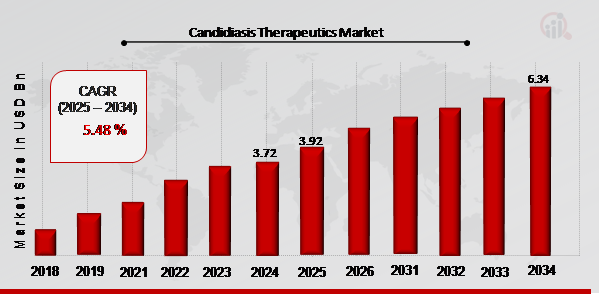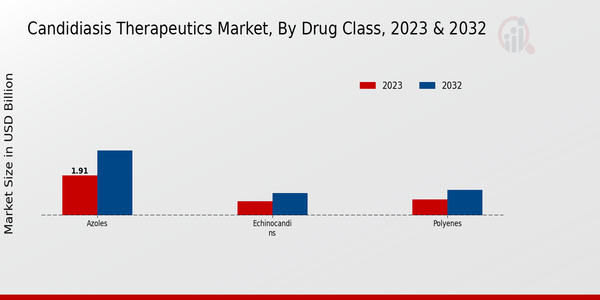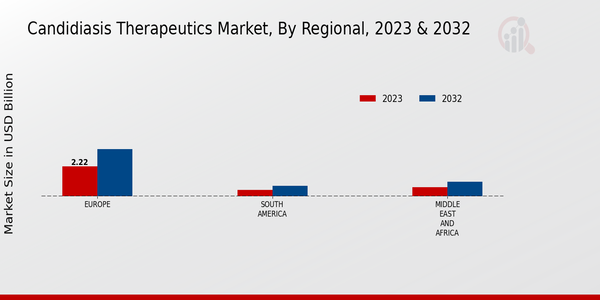Candidiasis Therapeutics Market Overview
As per MRFR analysis, the Candidiasis Therapeutics Market Size was estimated at 3.72 (USD Billion) in 2024. The Candidiasis Therapeutics Market Industry is expected to grow from 3.92 (USD Billion) in 2025 to 6.34 (USD Billion) till 2034, at a CAGR (growth rate) is expected to be around 5.48% during the forecast period (2025 - 2034).
Key Candidiasis Therapeutics Market Trends Highlighted
Rapidly evolving epidemiology of candidiasis infections, emergence of antifungal resistance, and increasing prevalence of immunocompromised patients are key drivers shaping the market for candidiasis therapeutics.
The increasing incidence of invasive candidiasis, particularly among hospitalized patients with weakened immune systems, presents significant growth opportunities for manufacturers focusing on the development of innovative antifungal therapies.
Technological advancements, including the advent of novel antifungal agents with improved efficacy and reduced side effects, are expected to drive market expansion. Additionally, the growing emphasis on early diagnosis, proactive treatment, and preventive measures is creating a favorable environment for market growth.

Source: Primary Research, Secondary Research, MRFR Database and Analyst Review
Candidiasis Therapeutics Market Drivers
Rising Prevalence of Candidiasis
Candidiasis is an infectious disease caused by candida fungi, the usual habitat of which is human skin, mucous membranes, and the gastrointestinal tract. Such a factor as the increasing prevalence of the disease drives the candidiasis therapeutics market.
Among the most common factors causing the increased frequency of the disease development, the inappropriate use of antibiotics, the increasing population of immunocompromised people due to HIV/AIDS, cancer, and organ transplants, and the increasing number of people using medical devices may be distinguished. The increased prevalence of the disease will contribute to the demand for efficient and safe therapeutics due to the necessity to develop new approaches.
Development of New Antifungal Drugs
Another major driver of the growth of the candidiasis therapeutics market is the development of new antifungal drugs. There have been significant advances in the field of new antifungal drugs in recent years, including the echinocandins, azoles, and polyenes, which is also boosting the growth of the candidiasis therapeutics market.
These new drugs are more effective and have fewer side effects compared to the traditional antifungal drugs. For this reason, the new antifungal drugs will continue to drive the growth of the candidiasis therapeutics market.
Increasing Demand for Prophylactic Antifungal Drugs
Another major driver of the growth of the candidiasis therapeutics market is increasing demand for prophylactic antifungal drugs. Prophylactic antifungal drugs are used to prevent candidiasis in high-risk patients, such as those with neutropenia, patients undergoing major surgery and those on chemotherapy.
The increasing demand for prophylactic antifungal is because of the rising number of immunocompromised patients and the increasing awareness about candidiasis and the methods to prevent it. As prophylactic antifungal provides a safe and effective method to prevent candidiasis in high-risk patients, the market for it is expected to continue growing.
Candidiasis Therapeutics Market Segment Insights:
Candidiasis Therapeutics Market Drug Class Insights
The Candidiasis Therapeutics Market is segmented based on drug class into azoles, echinocandins, and polyenes. The largest market share was held by azoles. It is expected to continue to lead during the forecast period. The use of azoles for the treatment of candidiasis is thus widespread since they are considered first-line therapy for this infection, given their favorable safety profile, broad-spectrum activity, and cost-effectiveness.
Consequently, the development of azole-resistant species of candida is concerning, and this might increase the demand for alternative classes of therapeutics that constitute the second-largest category of the anti-fungal market.
Echinocandins are an important class of antifungal drugs used for treating candidiasis. These drugs work by inhibiting the synthesis of beta-glucan, one important component of the fungal cell wall. The advantages of echinocandins is that they are generally well-tolerated, with candida species of low risk of developing resistant. In addition, most of these drugs are given by parenteral administration, which aids in the delivery of the optimal dose to the patients. However, they are expensive when compared to azoles. And serious but rare side effects of some echinocandins such as hepatotoxicity are also a hindrance to their use.
Polyenes are a class of antifungal drugs that are effective against a broad spectrum of candida species, which includes azole-resistant strains. They have been in use for a long period of time for the treatment of candidiasis and act by binding to ergosterol, an important component of the microbial key membrane component and survival. It kills the cell in this process. However, the toxic potential of polyenes is greater than both echinocandins and azoles. Some of the serious side effects of these drugs are such as nephrotoxicity and electrolyte imbalances are significant.

Source: Primary Research, Secondary Research, MRFR Database and Analyst Review
Candidiasis Therapeutics Market Indication Insights
The market for candidiasis therapeutics is segmented based on Indication into oral candidiasis, vulvovaginal candidiasis and invasive candidiasis. Oral candidiasis held the largest market share of 37% in 2023.
Oral candidiasis is a fungal infection of the mouth and throat caused by the candida species, commonly known as thrush. It is a common infection, particularly in babies, young children, and people with weak immune systems. The treatment procedures for oral candidiasis include antifungal medications namely nystatin, clotrimazole, fluconazole.
Vulvovaginal candidiasis is expected to record the highest growth during the forecast period. Vulvovaginal candidiasis is a common and superficial fungal infection occurring in the vagina and vulva among women caused by the Candida species, commonly known as a yeast infection. The treatment procedures for vulvovaginal candidiasis include antifungal medications namely clotrimazole, miconazole, fluconazole.
Invasive candidiasis is expected to account for a considerable share of the market. Invasive candidiasis is a life-threatening fungal infection that could impact multiple organs and tissues of the body including blood, heart, brain, the interior of other body organs, and the lungs. It could be a fatal infection particularly in individuals with low immunity. The treatment procedures include antifungal medications namely fluconazole, voriconazole, caspofungin.
Candidiasis Therapeutics Market Route of Administration Insights
The Candidiasis Therapeutics Market is segmented based on route of administration into oral, intravenous, and topical. Among these segments, the oral segment is expected to hold a significant share of the market in 2023, owing to the ease of administration and widespread availability of oral antifungal medications.
The Intravenous segment is also expected to witness considerable growth, due to the increasing prevalence of severe and invasive candidiasis infections. The topical segment is anticipated to expand at a steady pace, driven by the growing demand for topical antifungal creams and ointments for the treatment of localized candidiasis infections.
Candidiasis Therapeutics Market Patient Population Insights
The candidiasis therapeutics market is segmented by patient population into adults, children, and immunocompromised patients. Adults represent the largest segment, accounting for over 60% of the market share in 2023.
The high prevalence of candidiasis in adults is attributed to factors such as increased susceptibility due to aging, presence of underlying medical conditions, and frequent use of antibiotics. Children account for a significant portion of the market, with an estimated market share of around 25% in 2023. The incidence of candidiasis in children is particularly high in premature infants and those with weakened immune systems.
Immunocompromised patients, including those with HIV/AIDS, cancer, and organ transplants, are at an increased risk of developing candidiasis. This segment is expected to witness a steady growth in the coming years due to the rising prevalence of immunocompromising conditions and the increased use of immunosuppressive therapies.
Candidiasis Therapeutics Market Regional Insights
The regional segmentation of the Candidiasis Therapeutics Market presents distinct market dynamics and growth opportunities. North America dominates the market with a significant share, driven by factors such as high healthcare expenditure, rising prevalence of candidiasis, and the presence of leading pharmaceutical companies.
Europe follows closely, with a well-established healthcare system and a growing geriatric population susceptible to candidiasis. The APAC region is expected to witness substantial growth over the forecast period, owing to increasing healthcare awareness, rising disposable income, and expanding access to healthcare infrastructure. South America and MEA represent emerging markets with untapped potential, offering promising growth prospects for candidiasis therapeutics.

Source: Primary Research, Secondary Research, MRFR Database and Analyst Review
Candidiasis Therapeutics Market Key Players and Competitive Insights:
Major players in the candidiasis therapeutics market are constantly innovating and developing new products to meet the evolving needs of patients and healthcare providers. Leading market players are focusing on the development of novel therapies that are more effective, safer, and have fewer side effects.
For instance, in 2023, Pfizer announced the launch of a new antifungal medication for the treatment of invasive candidiasis. This new drug is designed to provide broader coverage against Candida species and has demonstrated improved efficacy in clinical trials. Such advancements in are expected to drive the growth of the market in the coming years.
The market’s competitive landscape is characterized by the presence of several key players, including Pfizer, Merck & Co., Inc., and Gilead Sciences, Inc. These companies hold a significant market share and are actively engaged in research and development activities to expand their product portfolios.
Pfizer is a leading player, known for its strong portfolio of antifungal medications. The company's flagship product, Diflucan, is a widely used treatment for a variety of Candida infections. Pfizer is also actively involved in the development of new antifungal therapies, and in 2023, the company announced the launch of a new drug for the treatment of invasive candidiasis. This new drug is expected to further strengthen Pfizer's position in the market.
Merck & Co., Inc. is another major player in the candidiasis therapeutics market. The company's antifungal portfolio includes Cancidas, which is approved for the treatment of a variety of Candida infections, including invasive candidiasis. Merck is also actively involved in the development of new antifungal therapies, and in 2023, the company announced the initiation of a Phase III clinical trial for a new drug for the treatment of vulvovaginal candidiasis. This new drug has the potential to be a significant addition to Merck's antifungal portfolio.
Key Companies in the Candidiasis Therapeutics Market Include:
- Pfizer
- Johnson & Johnson
- Sun Pharmaceutical Industries Ltd.
- Teva Pharmaceutical Industries Ltd.
- Shionogi & Co. Ltd.
- Cadila Healthcare
- GlaxoSmithKline
- Novartis AG
- Mylan N.V.
- HoffmannLa Roche Ltd.
- Astellas Pharma Inc.
- Cipla
- BristolMyers Squibb
- Merck & Co. Inc.
Candidiasis Therapeutics Market Developments
The Candidiasis Therapeutics Market is poised to reach USD 5.4 billion by 2032, exhibiting a CAGR of 5.48% during the forecast period (2024-2032). The rising prevalence of Candida infections, coupled with increasing healthcare expenditure and government initiatives to combat infectious diseases, is driving market growth. Furthermore, the development of novel antifungal drugs and the introduction of combination therapies are expected to fuel market expansion.
Recent news highlights include the FDA approval of Scytale's antifungal drug Recorlev in 2023, expanding treatment options for invasive candidiasis. Additionally, researchers at the University of California, San Francisco are investigating the use of CRISPR-Cas gene editing technology to develop new antifungal therapies, offering promising prospects for the future.
Candidiasis Therapeutics Market Segmentation Insights
Candidiasis Therapeutics Market Drug Class Outlook
- Azoles
- Echinocandins
- Polyenes
Candidiasis Therapeutics Market Indication Outlook
- Oral Candidiasis
- Vulvovaginal Candidiasis
- Invasive Candidiasis
Candidiasis Therapeutics Market Route of Administration Outlook
Candidiasis Therapeutics Market Patient Population Outlook
- Adults
- Children
- Immunocompromised Patients
Candidiasis Therapeutics Market Regional Outlook
- North America
- Europe
- South America
- Asia Pacific
- Middle East and Africa
|
Report Attribute/Metric
|
Details
|
|
Market Size 2024
|
3.72 (USD Billion)
|
|
Market Size 2025
|
3.92 (USD Billion)
|
|
Market Size 2034
|
6.34 (USD Billion)
|
|
Compound Annual Growth Rate (CAGR)
|
5.48 % (2025 - 2034)
|
|
Report Coverage
|
Revenue Forecast, Competitive Landscape, Growth Factors, and Trends
|
|
Base Year
|
2024
|
|
Market Forecast Period
|
2025 - 2034
|
|
Historical Data
|
2020 - 2024
|
|
Market Forecast Units
|
USD Billion
|
|
Key Companies Profiled
|
Pfizer, Johnson & Johnson, Sun Pharmaceutical Industries Ltd., Teva Pharmaceutical Industries Ltd., Shionogi & Co. Ltd., Cadila Healthcare, GlaxoSmithKline, Novartis AG, Mylan N.V., F. HoffmannLa Roche Ltd., Astellas Pharma Inc., Cipla, BristolMyers Squibb, Merck & Co. Inc.
|
|
Segments Covered
|
Drug Class, Indication, Route of Administration, Patient Population, Region
|
|
Key Market Opportunities
|
1. Growing Prevalence of Candidiasis
2. Innovative Antifungal Therapies
3. Rising Demand for Non-prescription Drugs
4. Increasing Awareness about Candidiasis Prevention
5. Expanding Geographic Reach
|
|
Key Market Dynamics
|
1. Rising Prevalence of Candidiasis
2. Advancements in Antifungal Therapies
3. Growing Demand for Prophylactic Antifungal Drugs
4. Increasing Focus on Targeted Drug Delivery
5. Integration of Diagnostics with Therapeutics
|
|
Countries Covered
|
North America, Europe, APAC, South America, MEA
|
Frequently Asked Questions (FAQ) :
The Candidiasis Therapeutics Market reached USD 3.34 billion in 2023.
The Candidiasis Therapeutics Market is expected to grow at a CAGR of 5.48% from 2024 to 2032.
North America is expected to hold the largest market share in the Candidiasis Therapeutics Market in 2023.
Rising prevalence of candidiasis, increasing demand for antifungal drugs, and growing awareness about candidiasis are the key factors driving the growth of the Candidiasis Therapeutics Market.
Pfizer, Merck & Co. Inc., and Gilead Sciences, Inc. are the major players in the Candidiasis Therapeutics Market.
The different types of candidiasis therapeutics available in the market include azoles, polyenes, and echinocandins.
The major applications of candidiasis therapeutics include the treatment of oral candidiasis, vulvovaginal candidiasis, and invasive candidiasis.
The challenges faced by the candidiasis therapeutics market include the emergence of drug resistance and the high cost of antifungal drugs.
The Candidiasis Therapeutics Market is expected to grow steadily in the future due to the increasing prevalence of candidiasis and the development of new antifungal drugs.
The key trends in the Candidiasis Therapeutics Market include the growing adoption of combination therapies and the development of new antifungal drugs with improved efficacy and safety.
















